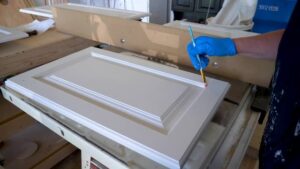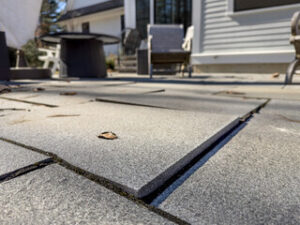Patriot Garage Door can be made of wood, aluminum (for areas with high salt content) or steel. They are available uninsulated or insulated with one to three layers, the latter providing higher insulating values.

Garage door openers that are 15 years old or older may have fixed security codes that can be eavesdropped by intruders. Newer models have rolling codes that change every time you use the remote.
At the turn of the century, car owners recognized they needed a new kind of outbuilding to store their cars. Traditional barn doors swung outward on hinges, requiring a large space that was frequently blocked by impediments such as snow and debris. They also required heavy and often difficult to maintain hardware.
CG Johnson set out to design a garage door that would rise parallel with the roof of the garage, making it more practical and safer than existing options. His upward-acting, sectional garage door revolutionized the way cars were stored forever. It also launched the Overhead Door Brand, now with over 450 red ribbon distributors across North America.
Garage door technology has evolved significantly since the first overhead track system was introduced in 1921. Today’s high-performance doors offer a host of features above and beyond standard coiling, roll-up or sectional doors. These include insulation, impact resistance, energy efficiency and more. These systems are designed for longevity, backed by the industry’s best warranty and supported by the Overhead Door(r) Distributor Network.
In addition to high-performance doors, the Overhead Door Brand offers a full range of residential garage doors and openers that blend beauty with functionality. These doors are available in a wide variety of styles and materials, including wood, steel and aluminum.
The Overhead Door Corporation is the leading single source supplier of integrated door and operator systems for commercial, industrial, retail and residential applications. Its broad product line includes garage doors and operators, operator accessories and parts, industrial doors, and security grilles and shutters. The Company also provides integrated access and control solutions, as well as maintenance and repair services. The Overhead Door(r) Brand is known for quality, reliability and trusted service. It is a symbol of strength and professionalism that carries on a 100-year legacy of innovation, leadership and expertise. Learn more at the Overhead Door(r) website.
Sectional Door
As its name suggests, this type of garage door consists of multiple panels connected by hinges. They enable the door to bend and curve as it goes up and down, which allows it to fit into a narrower space than single-panel garage doors. This design also makes the doors easier to operate. They are typically assisted by spring mechanisms that help them move smoothly, and most modern ones can be opened or closed with an automated system.
Besides being easy to operate, a sectional garage door also provides great protection against harsh weather conditions. Most of these doors have rubber seals that prevent rain, snow, and debris from entering the garage. They also come with insulation that helps keep the temperature of your garage at a more stable level, making them more energy-efficient.
A sectional door can be customized to match the overall design of your home. Many manufacturers offer a wide range of colors and finishes, so you can choose the one that fits your preferences. Most homeowners opt for neutral shades like black, white, and various shades of gray. Some companies also offer woodgrain finishes for a more traditional look. For more customization, you can add a window or two to the garage door to let in natural light and improve your curb appeal.
Another feature of a sectional door that separates it from single-panel options is its locking mechanism. Most of these doors have a lock that keeps the door from being jerked up or pushed open by intruders, giving you more security for your possessions and family members. Some are even designed to withstand high winds.
A good sectional garage door can last up to 30 years with regular maintenance. You can ensure that yours is working well by examining the track and rollers regularly. If you notice that your garage door isn’t moving smoothly, it’s probably time to change the tracks or adjust the tension of the springs. A quick check can help you save on expensive repairs and replacements down the road.
Roller Door
Unlike sectional doors, roller garage doors don’t roll up into a coil but rather slide along rails on the ceiling of your garage to rest parallel to it. They require less internal headroom and are a popular choice for commercial buildings, where they can also help with regulating airflow. These doors are sturdy and durable, allowing you to park your vehicle closer while still being easy to open. They can be fitted with a range of different window options, including frosted glass and insulated panels. These doors are also easy to use manually if the power fails, with a winding mechanism that you can turn with your hands in an emergency.
Like all garage doors, a quality roller door will need regular maintenance to keep it in good working condition. This includes lubricating the moving parts to ensure they work smoothly and safely. It’s also important to clean your garage from time to time to prevent dirt and debris buildup, which can affect the smoothness of operation. You should also keep an eye out for any signs of wear and tear, which might indicate it’s time to replace your garage door.
Roller doors tend to be cheaper than sectional doors and offer a great deal of customization. They can be made from a variety of materials, colours, patterns and textures. This versatility allows them to be incorporated into nearly any architectural style, making them a popular choice for homes.
Another benefit of roller doors is their relatively low maintenance cost. They have fewer moving parts than other types of garage doors, which makes them easier to maintain. However, they do need regular lubrication and should be checked for any issues every six months.
Wood Door
Wood doors are a great option for homeowners looking to add a traditional and classy look to their home. They are available in a variety of styles and finishes to suit any design preferences. They are also extremely durable, withstanding years of use without showing signs of wear. Although they do not provide as much insulating power as steel, they are still an effective barrier against the elements. Wooden doors are also easy to repair, and can be re-stained when you want to change the look of your door.
Unlike steel doors, wooden doors can be crafted from any type of wood you desire, so you can find one that matches your home’s architectural style. Depending on the type of wood used, it can be stained, painted or finished with a clear coat to protect it from moisture and other environmental factors. Wooden doors are also an excellent choice for those who want to increase the security of their homes, as they can be more easily customized with lock systems.
Solid wood doors are often more expensive than their metal counterparts, but the beauty and durability of a real wood door make them a worthy investment for many homeowners. However, they require more care and maintenance than other types of doors because they are made from a natural material that can expand or contract based on the humidity. They can be harder to fit, too, and may need alterations and adjustment after installation.
To construct a wood door, start by cutting two stiles to a length equal to the overall height of the door, minus the width of the top rail and bottom rail, plus one inch. Next, cut three rails from the shorter lumber to a length equal to the overall width of the door minus the height of the top and bottom rails, plus one inch to allow for tenons.
Once the rails and mullions are in place, assemble the door by gluing all of the mating surfaces. Liberally apply wood glue to each of the tenons and panels, then insert them into the stiles. Using 3-4 clamps, secure the assembly and let it dry overnight.




